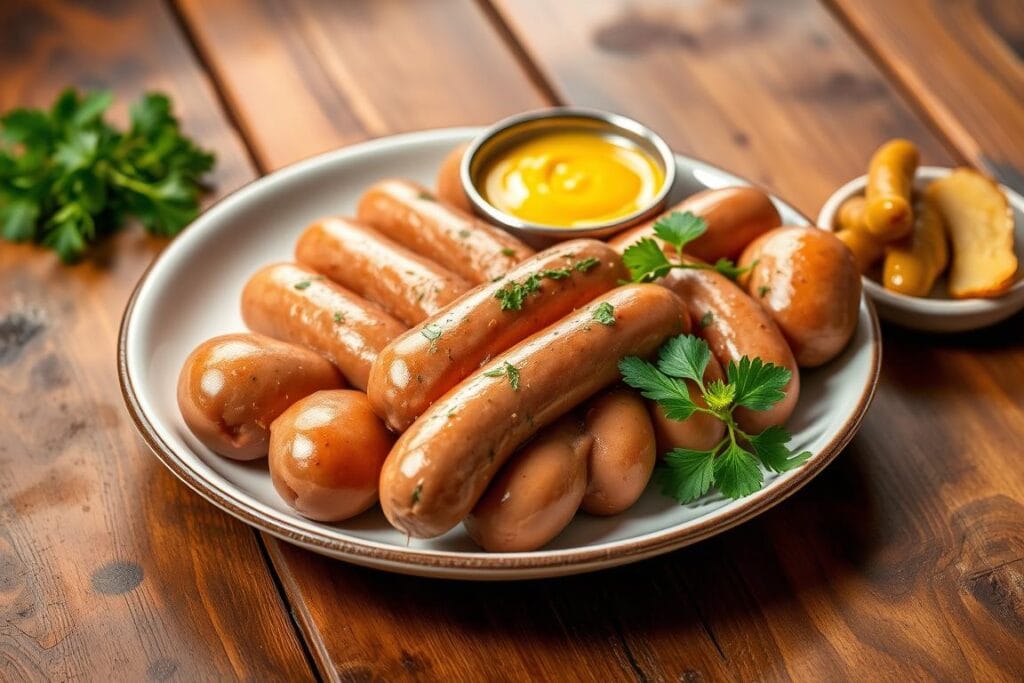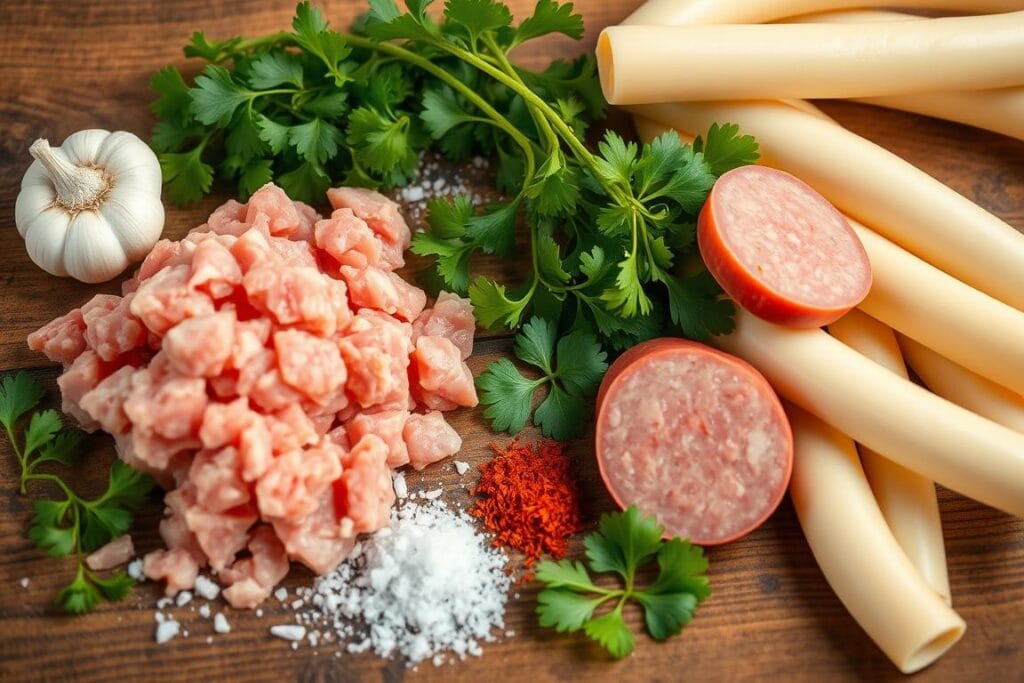Vienna sausage comes from Austria and is known for its delicate flavor and smooth texture. It’s great as a snack or in dishes like macaroni and cheese. This sausage has a rich history and is a culinary classic worth celebrating.
Whether you’re new to cooking or experienced, Vienna sausage is versatile. It’s also affordable, making it a smart choice for meals. You can use it in many dishes, like mini corn dogs and salads, showing its adaptability.
What Are Vienna Sausages and Their Origin
Wondering about the origins of Vienna sausages? They have a rich history from Europe. They were first sold at street stands, known as Würstelstand. Vienna is famous for these stands, with many types of sausages available.
In North America, Vienna sausages are smaller, smoked, and canned. They are made from chicken, beef, turkey, and pork. The meat is ground into a paste and mixed with salt and spices.
Some popular types of Vienna sausages include:
- Frankfurter: a classic sausage made from a combination of meats and spices
- Käsekrainer: a sausage that includes bits of cheese that can ooze out when sliced
- Debreziner: a Hungarian-origin sausage spiced with paprika, providing a spicier option
Trying vienna sausage recipes offers many options. You can choose from a traditional Frankfurter or something more adventurous like the Debreziner. Vienna sausages are a tasty and convenient snack with a rich history.

| Type of Sausage | Origin | Description |
|---|---|---|
| Frankfurter | Vienna, Austria | A classic sausage made from a combination of meats and spices |
| Käsekrainer | Vienna, Austria | A sausage that includes bits of cheese that can ooze out when sliced |
| Debreziner | Hungary | A sausage spiced with paprika, providing a spicier option |
Understanding Vienna Sausage Ingredients
Vienna sausages are made from a mix of meats and spices. They are usually a blend of pork and beef. These are seasoned with salt, white pepper, nutmeg, and other spices. This makes them a shelf-stable meat that’s easy to store and eat.
The ingredients in Vienna sausages can change based on the brand and where they’re made. But, most often, they include:
- Pork and beef, finely ground for a smooth texture
- Salt, white pepper, and other spices to enhance flavor
- Nutmeg and other seasonings to add depth and complexity
One great thing about Vienna sausages is how long they last. This is because of the shelf-stable ingredients. They’re simple yet tasty, making them a great choice for a quick meal.

Vienna sausages are a good source of protein. They can be part of a healthy diet. But, they do have a lot of sodium and saturated fat. So, it’s important to eat them in moderation. Knowing what’s in Vienna sausages helps you make better food choices.
| Ingredient | Percentage |
|---|---|
| Pork and beef | 70-80% |
| Salt and spices | 10-15% |
| Nutmeg and other seasonings | 5-10% |
The Manufacturing Process Behind Vienna Sausages
Understanding how Vienna sausages are made is key to knowing how to eat them. They are a mix of beef and pork, canned or packaged for easy eating. But what’s in a Vienna sausage? It usually has meats, spices, and preservatives, depending on the brand.
The making of Vienna sausages involves several steps. First, the meats are ground and mixed with spices and preservatives. Then, the mixture is stuffed into casings. After cooking, the sausages are ready for packaging and distribution. Some makers stick to old ways, while others use new methods.
Here are some important facts about making Vienna sausages:
- The USDA sets a 30% fat limit in sausages.
- Cooked sausages can’t have more than 10% water.
- Some use up to 20% mechanically separated meat.
Quality and safety are top priorities for sausage makers. They follow strict rules to make sure their sausages are safe. This includes regular checks and tests to meet standards.
| Manufacturer | Product | Ingredients |
|---|---|---|
| Armour | Vienna Sausage | Beef, Pork, Spices, Preservatives |
| Vienna Beef | Natural Hickory-Smoked Vienna Sausages | Beef, Pork, Spices, Smoke Flavoring |
Popular Vienna Sausage Brands in America
There are many vienna sausage brand options in the American market. These brands offer a variety of products, from classic sausages to unique flavors. Some well-known brands include Vienna Beef, Armour, and Bryan.
These popular snack brands are favorites in American cuisine. Many people enjoy them as a quick meal or snack. For example, Vienna Beef has different sausage sizes and types, like Cocktail Franks and Jumbo Franks.
Here are some key features of popular Vienna sausage brands:
- Vienna Beef: Offers a range of sausage products, including Polish Sausage and Frankwurst
- Armour: Known for their Hot and Spicy and Barbecue versions, which were winners in a taste test
- Bryan: Offers a range of sausage products, including hot and mild varieties
There are many other vienna sausage brand options in the market. Consumers can find a variety of products, each with its own unique flavor and texture. Whether you prefer a classic sausage or something more adventurous, there’s a popular snack brand for you.
| Brand | Product | Features |
|---|---|---|
| Vienna Beef | Polish Sausage | Made with fresh, domestic beef and a century-old family recipe |
| Armour | Hot and Spicy | Winner of a taste test, known for its spicy flavor |
| Bryan | Hot Variety | Known for its spicy flavor, but received mixed reviews in a taste test |
Creative Ways to Prepare Vienna Sausages
Vienna sausage recipes offer endless possibilities. You can enjoy them as a simple snack or as a main ingredient in various dishes. Cocktail sausages are great for parties, and vienna sausages can serve the same purpose.
Consider serving them with cheese and crackers or as a topping for salads or baked potatoes. You can also wrap them in croissant dough for a tasty pigs in a blanket snack.
For a heartier meal, add vienna sausages to pasta dishes or use them on pizzas. They’re also perfect in breakfast items like scrambled eggs or omelets. With a bit of creativity, you can make many delicious vienna sausage recipes.
Here are a few ideas to get you started:
- Try serving vienna sausages with tangy BBQ sauce
- Use them as a topping for baked potatoes or salads
- Wrap them in croissant dough for a tasty pigs in a blanket snack
- Add them to pasta dishes or use them as pizza toppings
Nutritional Profile and Storage Tips
When thinking about are vienna sausages healthy to eat?, we need to look at their nutrition. Vienna sausages are a good snack choice, with fewer calories and fat. They are also shelf-stable meat, making them simple to store and eat.
Some important nutritional facts about Vienna sausages include:
- Low in calories and fat, with about 10-15 grams of fat per serving
- Sodium content ranges from 600 to 800 mg per serving
- They can be part of quick meals or snacks, eaten cold or heated
To keep Vienna sausages fresh longer, following proper storage tips is key. Unopened cans can last 2 to 5 years at room temperature. Opened sausages should be eaten in 3 to 4 days for best taste and safety. Refrigerate opened sausages at or below 40°F (4°C).
Knowing the nutritional profile and storage tips for Vienna sausages helps you make better choices. They are a healthy and easy-to-store option for quick snacks or meals.
Vienna Sausage vs Other Processed Meats
When looking at what is the difference between hot dogs and vienna sausages, we need to check their ingredients, nutrition, and how long they last. Vienna sausages have 130-150 calories in a 55-gram serving. They have 10-12 grams of protein and 10-13 grams of fat. Hot dogs have similar calories but can have different amounts of protein and fat.
It’s also important to think about sodium. Both Vienna sausages and hot dogs have a lot of sodium. Are vienna sausages healthy to eat? They can be okay in a balanced diet, but eating them too much is not good because of their sodium and saturated fat.
Let’s compare Vienna sausages with other processed meats:
- Vienna sausages: 130-150 calories, 10-12g protein, 10-13g fat per serving
- Hot dogs: similar caloric content, varying protein and fat levels
- Potted meat: 180 calories, 16g protein, 12g fat per 2-ounce serving
In short, Vienna sausages are tasty and easy to eat, but we should think about their nutrition. It’s good to compare them with other processed meats to make smart choices.
| Product | Calories | Protein | Fat |
|---|---|---|---|
| Vienna Sausages | 130-150 | 10-12g | 10-13g |
| Hot Dogs | similar | varies | varies |
| Potted Meat | 180 | 16g | 12g |
Budget-Friendly Meal Planning with Vienna Sausages
Vienna sausage recipes are great for saving money. They are affordable and versatile. You can make many easy snack ideas and meals without spending a lot. Canned foods like Vienna sausages are about 25% cheaper than eating out or buying fresh food.
Some tasty vienna sausage recipes include Arroz Con Salchichas, Korean-Style Sausage Stir-Fry, and Casserole recipes. These dishes are not only tasty but also won’t empty your wallet. A serving costs under $1. Here are some reasons to use Vienna sausages in your meal planning:
- Convenient: Vienna sausages are easy to store and can be used in many recipes.
- Affordable: They cost between $1 to $3 per can, making them a budget-friendly choice.
- Versatile: You can use Vienna sausages in at least 15 different meals or snacks, adding variety to your pantry.
Adding Vienna sausages to your meal planning can save you money and time. They last a long time and are easy to prepare. They’re perfect for busy families and individuals. So, why not try them out and see how convenient and affordable vienna sausage recipes can be?
| Recipe | Cost per Serving | Prep Time |
|---|---|---|
| Arroz Con Salchichas | Under $1 | Under 1 hour |
| Korean-Style Sausage Stir-Fry | Approx. $1.50 | Approx. 30 minutes |
Conclusion: Embracing the Convenience of Vienna Sausages
Vienna sausages are a great choice for your pantry. They’re perfect for a quick snack, a budget-friendly meal, or an emergency food supply. Their long shelf life and easy preparation make them great for busy lives.
Adding Vienna sausages to your meals is easy. They can make simple snacks or hearty casseroles. Try new recipes to see how versatile they are.
Enjoying Vienna sausages is easy, but eat them in moderation. Choose low-sodium options when you can. These canned meat classics are a must-have for a busy lifestyle.

